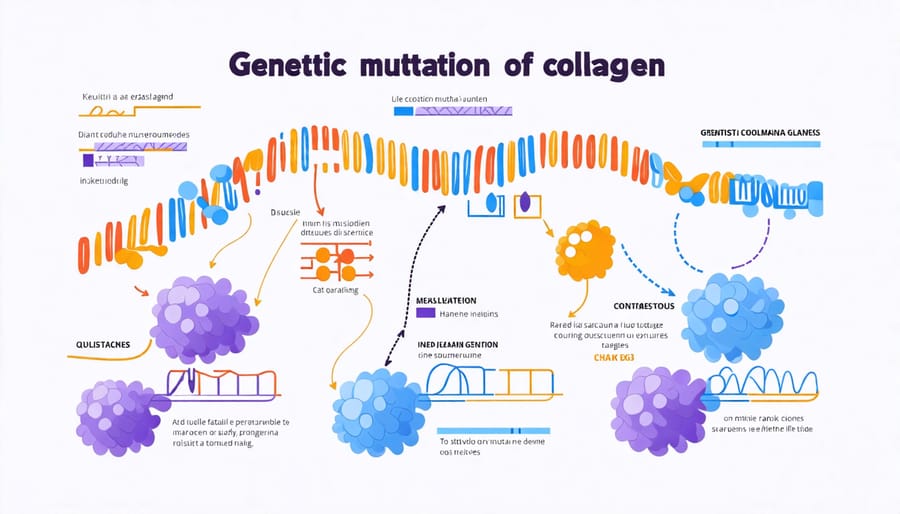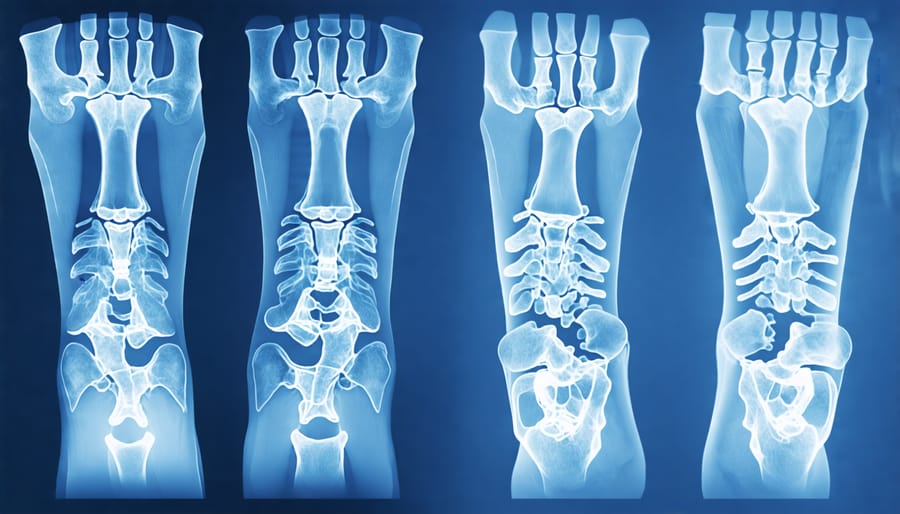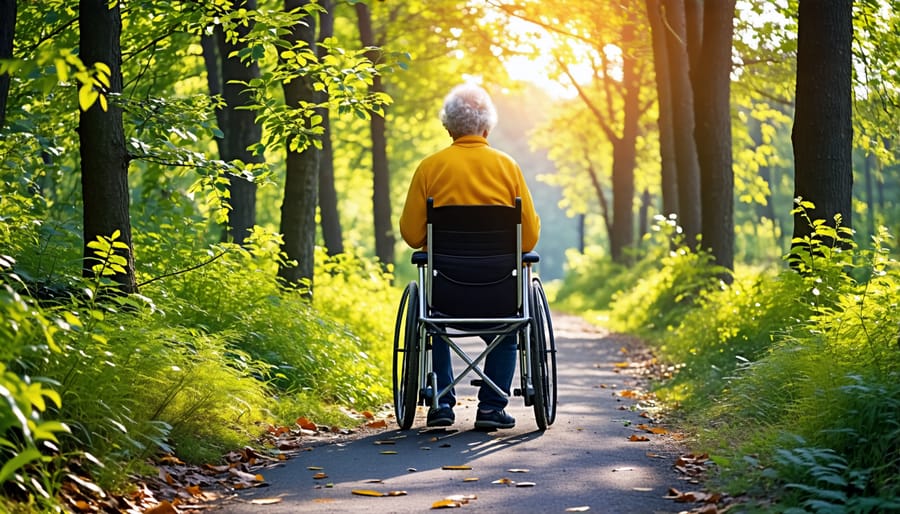Osteogenesis imperfecta (OI), also known as brittle bone disease, is a rare and complex genetic disorder that profoundly impacts the lives of those affected. For individuals with OI and their loved ones, the journey from diagnosis to managing daily life can be filled with challenges, uncertainties, and a quest for knowledge and support. This article aims to shed light on the intricacies of OI, providing a comprehensive overview of the condition, its symptoms, diagnosis, treatment options, and the resources available to help those living with OI navigate their unique experiences. By empowering readers with accurate information and a sense of community, we hope to foster resilience, hope, and a better quality of life for all those touched by this rare condition.
Causes and Types of OI
Genetic Mutations
Osteogenesis imperfecta (OI) is caused by genetic mutations that affect the production, structure, or processing of type 1 collagen, the main protein in bones, teeth, and connective tissues. In most cases, OI is due to mutations in the COL1A1 or COL1A2 genes, which provide instructions for making the two parts of the type 1 collagen molecule. These mutations can lead to a reduced amount of collagen or altered collagen structure, resulting in fragile bones that break easily. The severity of OI depends on the specific genetic mutation and how it impacts collagen production. Some mutations cause milder forms of OI, while others lead to more severe symptoms. Rarely, mutations in other genes involved in collagen processing or bone mineralization can also cause OI. Genetic testing can help identify the specific mutation responsible for an individual’s condition, which can inform prognosis and guide treatment decisions. Understanding the genetic basis of OI has also opened up new avenues for research into potential therapies targeting the underlying collagen defects.

Types of OI
There are several types of osteogenesis imperfecta (OI), each with varying degrees of severity. The most common classification system identifies four main types:
Type I is the mildest form, characterized by bones that break easily, blue sclera (whites of the eyes), and possible hearing loss. Individuals with Type I OI usually have a normal or near-normal stature.
Type II is the most severe form, often leading to stillbirth or death in infancy due to respiratory problems and multiple fractures. Babies with Type II OI have extremely fragile bones and underdeveloped lungs.
Type III is a severe form that causes frequent fractures, often from birth. Individuals with Type III OI typically have short stature, spinal curvature, and may require mobility aids. They can also experience respiratory and hearing issues.
Type IV is a moderate form, with symptoms ranging between Type I and Type III. Individuals with Type IV OI have moderately fragile bones, short stature, and may have blue sclera. Dental issues, such as brittle teeth, are also common.
While these are the primary types, other rare forms of OI exist with varying characteristics. Genetic testing can help determine the specific type of OI an individual has, enabling personalized treatment and management strategies.
Symptoms and Diagnosis
Symptoms
The main symptoms of Osteogenesis Imperfecta (OI) can vary in severity depending on the type of OI an individual has. Common symptoms include frequent bone fractures from mild trauma or no apparent cause, bone deformities such as bowed legs or curved spine, short stature, loose joints and muscle weakness, blue or grey tint to the whites of the eyes (blue sclera), triangular face shape, larger than normal head size (macrocephaly), hearing loss (often beginning in early 20s or 30s), brittle teeth (dentinogenesis imperfecta), and breathing problems. Pain from fractures, skeletal malformations, or compressed nerves can range from mild to severe. Fatigue, limited mobility, and challenges with daily activities may also occur. Symptoms are usually present from birth, although some types may have a later onset. While the primary feature is bone fragility, OI can affect multiple body systems. Severity spans a wide spectrum, with some individuals experiencing hundreds of fractures and others far fewer. Early diagnosis and a clear understanding of symptoms are vital for proactive management and enhanced quality of life.
Diagnosis
Diagnosing osteogenesis imperfecta (OI) involves a combination of physical examinations, medical history, and specialized tests. Genetic testing is a key diagnostic tool, as OI is caused by mutations in the genes responsible for collagen production. By analyzing a person’s DNA, doctors can identify specific genetic variations associated with different types of OI. This information helps predict the severity of the condition and guide treatment decisions.
In addition to genetic testing, bone density scans play a crucial role in diagnosing OI. These scans, such as dual-energy X-ray absorptiometry (DXA), measure the density and strength of the bones. People with OI typically have lower bone density compared to individuals without the condition. Bone density scans can also help monitor the effectiveness of treatments over time.
In some cases, prenatal ultrasounds may detect signs of OI in an unborn child, such as fractures or bowing of the long bones. However, milder forms of OI may not be apparent until after birth. Early diagnosis is essential for implementing appropriate care plans and support services to help individuals with OI maintain their health and quality of life.

Treatment and Management
Medical Treatments
Treating osteogenesis imperfecta (OI) involves a combination of medications, physical therapy, and supportive care to manage symptoms, prevent complications, and improve quality of life. Bisphosphonates are the primary medications used to treat OI. These drugs work by slowing down bone resorption, allowing the body to build stronger bones and reduce the risk of fractures. Commonly prescribed bisphosphonates include pamidronate and zoledronic acid, which are administered through intravenous infusion.
Physical therapy plays a crucial role in managing OI by helping individuals maintain muscle strength, joint flexibility, and overall mobility. Gentle exercises, such as swimming and low-impact aerobics, can improve bone density and reduce the risk of fractures. Occupational therapy helps adapt daily activities and the living environment to minimize the risk of falls and fractures.
Supportive care for OI may include pain management, bracing or splinting to stabilize fractures, and assistive devices like wheelchairs or crutches to aid mobility. In some cases, orthopedic surgery may be necessary to correct deformities or stabilize bones with rods. Regular monitoring by a multidisciplinary healthcare team, including orthopedists, endocrinologists, and physiotherapists, ensures comprehensive care tailored to each individual’s needs.
While there is no cure for OI, early diagnosis and appropriate treatment can significantly improve outcomes and quality of life. Ongoing research continues to explore new therapies, such as gene editing and stem cell treatments, offering hope for more effective management of this condition in the future.

Lifestyle Modifications
For individuals with osteogenesis imperfecta (OI), lifestyle modifications can play a crucial role in preventing fractures and maintaining mobility. One of the most important steps is to maintain a healthy weight, as excess weight puts additional stress on the bones and increases the risk of fractures. Engaging in low-impact exercises, such as swimming, cycling, or yoga, can help improve muscle strength, balance, and flexibility without placing undue strain on the bones.
Adequate nutrition is also essential for maintaining bone density and overall health. A balanced diet rich in calcium, vitamin D, and protein can support bone health and reduce the risk of fractures. Consulting with a registered dietitian can help individuals with OI develop a personalized nutrition plan that meets their specific needs.
Fall prevention is another critical aspect of fracture prevention for those with OI. This may involve making home modifications, such as installing grab bars, removing tripping hazards, and ensuring adequate lighting. Using assistive devices, such as canes or walkers, can also help improve stability and reduce the risk of falls.
Regular check-ups with a healthcare provider experienced in managing OI are essential for monitoring bone health, addressing any concerns, and adjusting treatment plans as needed. By adopting these lifestyle modifications and working closely with their healthcare team, individuals with OI can take proactive steps to prevent fractures and maintain their independence and quality of life.
Coping and Support
Living with osteogenesis imperfecta (OI) can present challenges, but with the right support and strategies, individuals with OI can lead fulfilling lives. Connecting with others who understand your experiences is invaluable. Consider joining support groups, either in-person or online, to share your struggles and successes with people who can relate. Organizations like the Osteogenesis Imperfecta Foundation offer resources, events, and a sense of community.
Adapting your environment and using assistive devices can help you navigate daily life more comfortably. Work with occupational therapists to identify tools and modifications that suit your needs, such as mobility aids, adaptive equipment for self-care tasks, and home modifications to improve accessibility.
Prioritizing your physical and mental health is crucial. Engage in safe, low-impact exercises as recommended by your healthcare team to maintain strength and flexibility. Pursue hobbies and activities that bring you joy and a sense of accomplishment. If you’re struggling emotionally, don’t hesitate to seek support from mental health professionals who can help you develop coping strategies and build resilience.
Remember, everyone’s journey with OI is unique. Be kind to yourself, celebrate your victories, and lean on your support network when needed. With the right mindset and resources, you can thrive and live life to the fullest.

